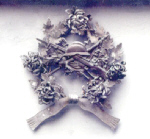

STOP XXVII

|
Kobarid
{Formerly Caporetto}
|
"Now, I will be here, here forever. Now, in complete peace, I can see the
green grass, the gray rocks, and the white snow. Now, I am as light as memory. Now,
I am a warning to you!"
Inscription at the Kobarid Ossuaria

Kobarid Once Known as Caporetto
Because of its location at the junction of the Soca and Nadiza valleys that link Friulia and Carinthia, Kobarid was the scene of numerous invasions and wars. In the past century, the flag flown over Kobarid's main square has changed some ten times. It was inhabited as early as the Hallstatt Age. The archeological finds dating back to the age of the Roman Empire speak of Kobarid as an important stopover point on the Aquileia-Noricum route. And in the Middle Ages the settlement was owned by the Cividale Chapter. In 1688 a devastating blaze swept through the settlement. Turkish hordes prowled this region and Napoleon's troops marched through these valleys. In memory of those times a bridge spanning the Soca was named Napoleon's Bridge.
Today Kobarid is a pleasant town dwarfed by towering mountains offering many points of interest and places ideal for hiking, hunting, and fishing. Marked trails lead from Kobarid to the mountaintops of Stol, Matajur, and Krn and to the waterfall of Kozjak. The Krn mountain range looming over Kobarid marks the fringe of Triglav National Park.

Model of the Caporetto Battlefield at the Museum
Kobarid gained world recognition thanks to the greatest highland battle in human history that took place during World War I. This region was the scene of the first swift, sudden military offensive today known by the German word "blitzkrieg". In October 1917, the Austrian and German armies dealt a decisive blow to the Italian armed forces near Kobarid. In only a few days, the two armies pushed Italian troops deep into the Italian territory, as far as the Piave river.
In the town center is located the award winning war museum. In the immediate vicinity of Kobarid, the dramatically located charnel house [ossuaria] gives visitors an opportunity to honor the fallen and the Kobarid Historical Trail offers easy access to the remains of the Italian third defense line. Accessible as well are mountain outposts of both armies, and via asphalt road the extensive area of the Kolovrat mountain range and the slopes of Mount Matajur.

The Current Museum Building During the War
In the memorial charnel house at Kobarid, there are mortal remains of 7014
Italian soldiers, which were brought there from the Upper Soaa Region. The most
shocking are the niches by the central staircase where the remains of 2748 unidentified
soldiers are deposited. The memorial charnel house was finished in 1938, in the time when Kobarid was under Italy. and Benito Mussolini himself was present at its consecration.
From the square at Kobarid, a road leads to the charnel house, by the
sculptor Giannino Castiglioni. The road ends at the foot of a pyramid-shaped charnel
house where the following words are engraved at the beginning of the central
staircase: May you be honoured who were killed as brave warriors.
From the charnel house on Sveti Anton hilla 6-km long path leads
across the remnants of the Italian third line of defence in World War I. The
path takes a hiker through a wood to the Napolion Bridge across the Soca where French Socldiers once marched. The original was destroyed by Austrian Soldiers in May 1915 and a temporary replacement was destroyed during the Battle of Caporetto by the retreating Italian 2nd Army.

The Charnel House [Ossuaria] with Mte Krn in the Distance
Across the bridge, in the direction of Dreznica, the path turns to the
left bank of the Soca and runs on rocky escarpment above the river. After
a few hundred meters, the path starts rising in zig-zag curves and finally
joins the cleared trenches which lead to Italian gun emplacements and observation
posts. Walking along this path is like experiencing an open-air museum
and it suitably complements the show in the Kobarid Museum itself.
Sporadic flowers, an idyllic waterfall, breathtaking river and alpine views and the greenery along the path enable a hiker to relive the unusual coexistence of nature and war.
Gathered from the Kobarid Tourism Website and pamphlets.
Visit John Farina's article on Caporetto to learn more on the Battle: Click Here
|

|








